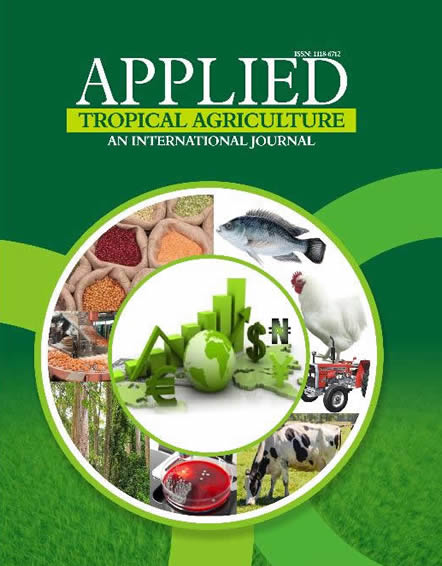The effect of repeated cuttings on herbage and seed yield characters were compared in three cultivars of Corchorus
olitorius during 2011 and 2012 cropping seasons. Seeds of Corchorus olitorius were steeped in hot water at 97oC for
five seconds before sowing by drilling directly on the field. Three different cutting frequencies (for herbage yield)
were applied by cutting the stem at 10 cm above the soil (for the first harvest) at 6, 9 and 12 weeks after sowing
(WAS) and herbage yield were recorded. At 15 WAS, plant height, number of leaves and number of branches were
recorded. After maturity, dry pods were harvested and data were collected on seed yield characters. Data obtained
were subjected to analysis of variance and means separation was carried out using DMRT at 5% probability level.
The result indicated that herbage yield/plant (25.71g), number of pods/plant (57.94 g) and pod weight/plant (15.76
g) were highest in plants pruned three times while highest seed yield of 8.41 g/plant (1.68 t/ha) were recorded in
cutting twice. Among the varieties, Amugbadu recorded highest number of pods/plant, pod weight/plant and seed
weight/plant whereas Eleti-Eku had the lowest. However, Eleti - Eku produced the highest 100 seed weight under
zero cutting (0.173g). Although cutting three times produced highest herbage yield, but cutting twice is
recommended if the objective is for seed production as it recorded highest seed yield.
Key words: Corchorus, cutting frequency, herbage yield, seed yield, seed production efficiency.
PAPER TITLE :ENHANCEMENT OF HERBAGE AND SEED YIELD IN CORCHORUS OLITORIUS THROUGH REPEATED CUTTING AGROTECHNIQUE
APPLIED TROPICAL AGRICULTURE | VOLUME 23 NUMBER 2 2018
Paper Details
- Author(s) : 1Abdul-Rafiu, A. M., 2Ajayi, O. O., 1Olomide, O. A. K. and 3Olofintoye, T. A. J.
- Abstract:


